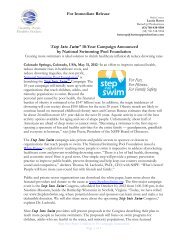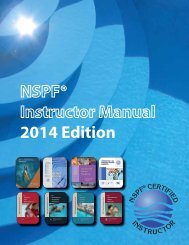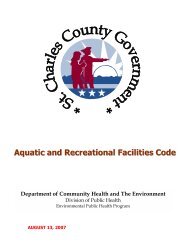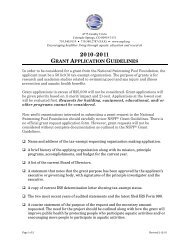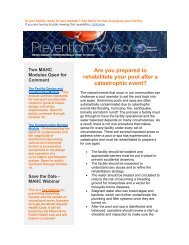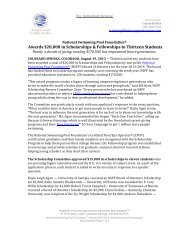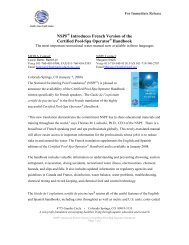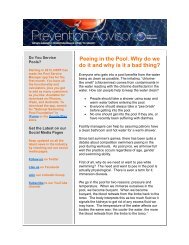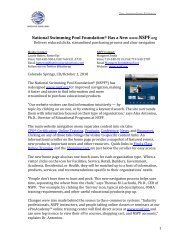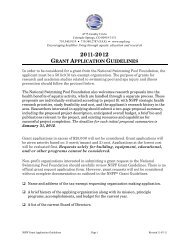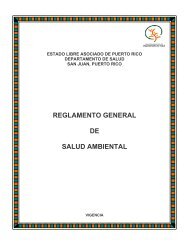English Instructor Manual (PDF) - Metric Version - National ...
English Instructor Manual (PDF) - Metric Version - National ...
English Instructor Manual (PDF) - Metric Version - National ...
Create successful ePaper yourself
Turn your PDF publications into a flip-book with our unique Google optimized e-Paper software.
Key Points: Explain that chlorine is the most common disinfectant used in commercial pools.<br />
While chlorine may not be the best disinfectant or the best oxidizer or the best algaecide, it is very<br />
good at all three and is one product. Explain that chlorine is present (percentage listed with each<br />
compound) in the following compounds commonly used to disinfect pools:<br />
Chlorine gas (100%)<br />
Calcium hypochlorite (65%-78%)<br />
Sodium hypochlorite (10%-12%)<br />
Lithium hypochlorite (35%)<br />
Trichlor (90%)<br />
Dichlor (56%-63%)<br />
Key Points: Discuss that chlorine compounds fall into two categories. These include:<br />
Organic chlorine compounds, such as trichlor and dichlor, contain cyanuric acid as part<br />
of the compound. They are considered stabilized chlorines.<br />
Inorganic chlorine compounds, such as calcium hypochlorite, sodium hypochlorite,<br />
lithium hypochlorite, and chlorine gas, do not contain cyanuric acid as part of the<br />
compound. They are considered unstabilized chlorines. However, these chlorines can<br />
be stabilized by adding cyanuric acid to the water as a separate product.<br />
Key Points: Discuss the use of stabilizers to increase the stability of chlorine in pool water.<br />
These include:<br />
Stabilizers decrease the breakdown of chlorine due to UV light.<br />
The stabilizer for chlorine is cyanuric acid.<br />
The ideal range for cyanuric acid levels is 30-50 mg/L.<br />
Local health codes may restrict the use of cyanuric acid in public pools or spas. It is<br />
important to check the local code.<br />
Key Points: Discuss the chemistry of chlorine. Explain that when a chlorine compound is<br />
introduced to water, the chemical reaction forms:<br />
Hypochlorous acid, which is the active killing form of chlorine in water.<br />
Hypochlorite ion, which is an inactive form of chlorine in water. By-products specifi c<br />
to the type of chlorine used. For example, the by-product of sodium hypochlorite (liquid<br />
bleach) is sodium chloride (table salt).<br />
Free Chlorine, sum of hypochlorous acid and hypochlorite ion.<br />
Combined Chlorine, reaction of free chlorine with inorganic and organic compounds in<br />
the water<br />
Key Points: Discuss the most common stabilized disinfectants and their chemistry:<br />
Trichloro-s-triazinetrione – commonly called trichlor<br />
Sodium dichloro-s-triazinetrione - commonly called dichlor<br />
Key Points: Discuss the various aspects of bromine. These include:<br />
There are two methods of using bromine. The most common is bromine tablets<br />
(BCDMH). The second is sodium bromide, which must be used with potassium<br />
monopersulfate. Potassium monopersulfate is a non-chlorine oxidizer.<br />
While bromine is a strong disinfectant, it is not as good as chlorine as an oxidizer.<br />
Because of this, the use of a supplemental chemical for oxidation is occasionally<br />
needed.<br />
Page 54<br />
© 2014 <strong>National</strong> Swimming Pool Foundation®



